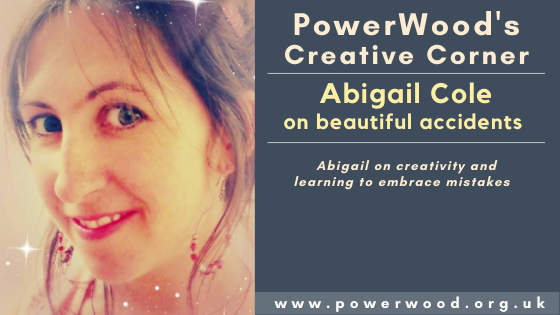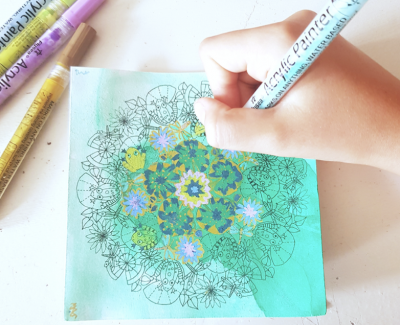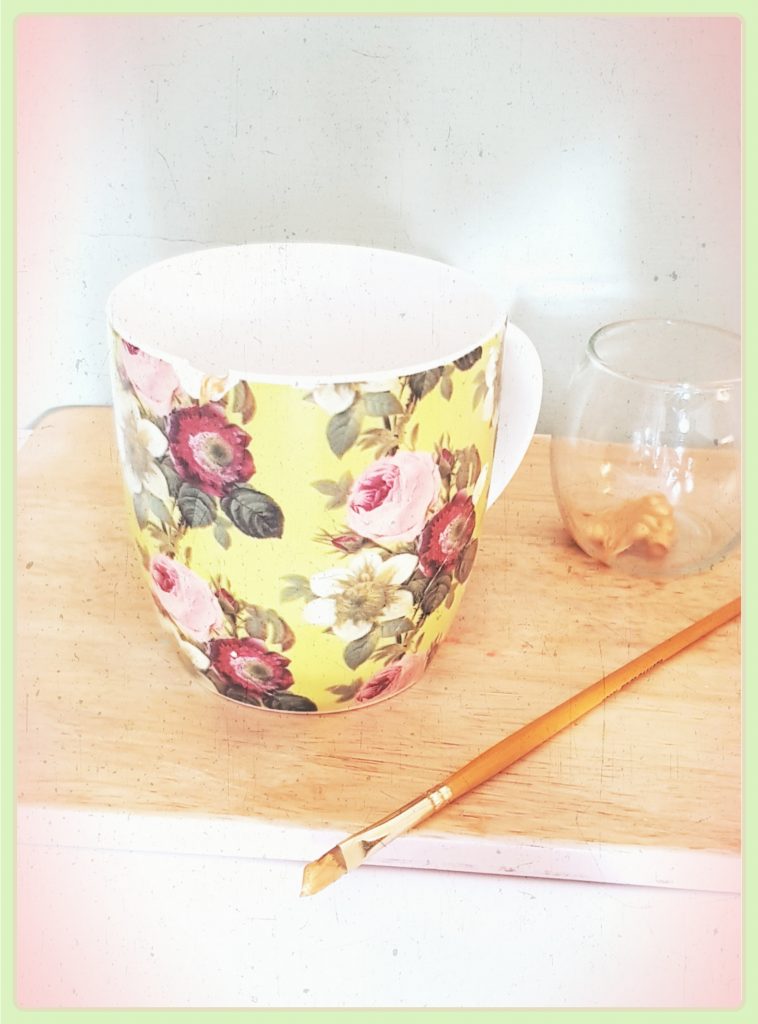
A beautiful accident
The image used for my last creative blog post (Crafting for Connection) was covered in a paint spill. I’m not sure how obvious that is to an outside eye, but we thought that the end result of that picture actually turned out quite beautifully. To get there however, definitely involved a bit of behind the scenes drama! My daughter was colouring her mandala picture and as she removed the lid of the paint pen she was using, the whole of the top part of the pen came off and paint spilled everywhere! Of course, we both reacted a little – her with tears of frustration and me leaping to find a cloth and capture all the paint and maybe rescue the pen. She panicked at having wasted one of my pens, but I am very accustomed these days, after much practice, to saying “don’t worry, it’s just a ‘thing’…” and trying to calm myself. As I was cleaning everything up with the damp cloth in my hand, I wiped over the image itself, without really thinking too much about what I was doing. The result was a beautiful green wash filling the background, and darker paint stains on the rest. The original colouring was still visible. And the more I gazed at it to examine the damage, the more kind of intentional it looked… if my daughter wanted to continue to colour and fill in the patterns she could easily do so (acrylic paint pens can be easily layered), and it would just look like she had deliberately painted the background. She didn’t choose to continue with the colouring at that moment, but we decided to use the image anyway, beautiful as it is.

As I reassured my daughter that I thought it was possibly even more beautiful than before (I truly love the way the colour combinations of green and gold blended!) and pondered on the situation moments later once everything was calm, I realised that we had just turned an accident and what felt to my daughter like an “epic fail” into something beautiful. We had embraced the mistake. And this in turn got me thinking about the numerous other occasions in which creativity has offered me this opportunity for learning and growth. Because even though it doesn’t always feel like it at the time – when we fail, we grow.
An opportunity for growth, through making mistakes
Creativity is a process and an intrinsically fertile space for this kind of learning:
The pumpkin carving that went wrong, due to a slip of the knife and meant my son stuck an onion in the cut-too-large mouth (making it look even more scary and sinister), ultimately winning the competition.
The smudge on a wall that I couldn’t remove so drew around it with sharpies and turned it into a mini-mural that stayed with us for years until we redecorated.
The numerous drawings and doodles that don’t end up being the thing we originally planned if we just keep going past the “mistake”.
The painting that was going to be a blue sky but turned into a beautiful deep sea that you could let your imagination get lost in …
The birthday cake disaster that became a genuine cake masterpiece a year later – my brave husband being the one who has to conjure-up magnificent birthday cakes in our house (I am useless at baking!) – went from an unrecognisable mermaid cake one year, to a full-on 3-dimensional Pokemon Bulbasaur cake the next – it was a success celebrated by numerous small children that year, even if it was short-lived as they set about carving ‘Bulbasaur’ up and voraciously devouring him!
I daresay that many of the images we see online of wonderful creations have involved such drama’s and mistakes along the way. And all of these are examples of mini-disasters that feel huge at the time; disappointment in creative endeavours can feel very real and challenging – especially for children, but that can give us a different sense of achievement to the one we planned; of having overcome an obstacle to get to our end result. This, in time, can feel even more rewarding than getting to a finished piece in one perfect straight line.
At the very least, learning through creative mistakes in this way, can help to cultivate an inner optimistic spirit of always finding ways to make the best of a tricky situation.

Embodied experience
Frequently when I am crafting and making, I will make little mistakes and rather than starting again, often being somewhat pressed for time and not wanting to waste anything, if I can’t fix it, I try to figure out what I can do with it instead. Not only are many great discoveries made this way, but over time, and many years of working creatively, it becomes a kind of reflex. It’s a kind of resilience training; without really being aware of it, and where the stakes are not too high. As upsetting as it can be to fail at a drawing for example, it’s possibly not the same as ‘failing’ in a more public arena, say at work or school. Engaging in a creative life can really offer a less threatening space to build up our “growth through failure” muscles, as we learn to embrace our mistakes.
Also, ‘learning through our mistakes’ when it comes to creativity, can be very literal. A lot of the time, we are doing or making something for the first time – following a new pattern, attempting something we’ve never painted before, trying a new craft – it intrinsically involves a lot of learning and re-learning. Something went wrong with the thing we were making, so we need to find out what it was that went wrong and technically try another approach. The more time we spend doing this, the more this kind of learning through things going wrong becomes a deeply embodied experience. Creativity and creative practice, I believe can be the epitome of a ‘growth mindset’; fundamentally being a mindset of learning and re-learning, through challenge and trial and error, and questioning how we can create beauty out of chaos.
Broken things can be beautiful
The Japanese art of Kintsugi captures the spirit of this beautifully. Kintsugi is a technique for repairing broken objects, usually ceramics, pottery, vases and so on, using a joining or repair medium mixed with gold dust. This enables the cracks and lines of the breaks to remain visible, and these are believed then to enhance the beauty of the original object.
Indeed, whilst exquisitely made objects offer a particular aesthetic of beauty, I do love it when hand-made pieces have tiny mistakes in them. For me, the little blemishes can be a part of an object’s charm and uniqueness. Somehow to me, visible mistakes can tell of a story of the maker and the journey that was undertaken to bring a creative work to fruition. They also, somehow, tell a story of our human-ness – all of us imperfect and learning as we go.
In the same way that Kintsugi is also a philosophy of life that extends far beyond fixing-up broken pots, our own creative endeavours can become a philosophy of life too; not only embracing the idea that there can be great beauty and strength beyond ‘brokenness’, but also accepting that some amount of tension and challenge – in the form of the perceived ‘mistakes’ that we make – is inevitable at times, and can also be a very good thing. When we use our creative reflexes to work around and embrace mistakes, it can lead to successes and beauty that we didn’t even imagine!
Resources
I’ve recently been enjoying the podcast How to Fail with Elizabeth Day (delightfully discovered after our paint-spill episode and very welcomed 😊 )
And a great book for introducing children to these ideas is You are Awesome by Matthew Syed – he uses humour and a wonderful lightness-of-touch to introduce ideas about growth through failure and presents the Growth Mindset theories of Carol Dweck.
If you feel inspired, why not also have a go at Kintsugi? One of our PowerWood Community members, Kirsty, has also been exploring Kintsugi herself, and would no doubt have many tips to share 😊.
© Abigail Cole 2020
Help us to continue support to all neurodiverse families and individuals
During these challenging times PowerWood facilitates access – also to non-members – to all information, tests, strategies and tools.
PowerWood offers to (self)-isolating families understanding, simple tools and strategies that enable us and our children to support ourselves and our children through emotional overwhelm. If you enjoy reading the articles please support PowerWood by becoming a PowerWood Community FreeBee or Friend member. Thank YOU!
